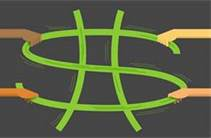 Some time ago when I first starting blogging here on WordPress I wrote a post about the Gold Standard. In it I tried to explain the concept in its most simple form. Today I’m going to try to explain the term of Elastic Currency. These two terms are linked together as monetary policy siblings and a thorough understanding of both concepts is a precursor to being able to fully understand the financial problems that face the United States.
Some time ago when I first starting blogging here on WordPress I wrote a post about the Gold Standard. In it I tried to explain the concept in its most simple form. Today I’m going to try to explain the term of Elastic Currency. These two terms are linked together as monetary policy siblings and a thorough understanding of both concepts is a precursor to being able to fully understand the financial problems that face the United States.
As with my Gold Standard article I’m not going to get too technical nor am I going to make too many suggestions as to whether or not this policy is best for the country and the world. I think it’s important to understand the concepts and only after that can people make informed decisions about the financial future of the United States.
The idea of Elastic Currency is that a central banking institute can expand or contract the amount of money available to lending institutions based on economic conditions. This is deemed to be important for two linked reasons. The history of economies throughout the world is a history of boom and bust cycles. These cycles bring tremendous hardships to nations and the goal is to alleviate the pain of these events.
In a boom/bust cycle a particular item becomes attractive to buyers which spurts a speculative interest in those sorts of items. Be it dotCom, Housing, or whatever. Basically people find that they can purchase the product and then sell it later for a profit. This fuels the boom. More and more people purchase the product which drives the prices higher and higher generating further profits and more speculation. The boom “bubble” grows and grows until the product is selling for far more than it is worth. Then, all the people holding the product at the end are bankrupted when people suddenly stop buying. This destroys economies because the people can’t pay back the money they’ve borrowed and the people who loaned the money also go bankrupt. Thus, there is no money to loan others and we enter bust.
The idea behind Elastic Currency is that a central banking institute recognizes a boom cycle is going on and reduces the amount of available currency to loan and tempers the speed and size of the bubble which bursts with far less grave consequences. Likewise, during the ensuing bust cycle the banking institute allows more money to become available for loans thus paving the way for new growth by those who played it safe and did not engage in the boom but would otherwise be shut out by the lack of available loans.
The demise of the Bretton Woods gold standard in 1971 and the rise of Bretton Woods II is clearly linked to the current level of indebtedness that the United States and much of Europe face. Whether there was another, better, solution is unclear.
So, that’s the main idea of Elastic Currency.
I promised not to make too many suggestions as to fixing the rising debt we face but one thing that I think has been ignored by the Federal Reserve and the financial agencies of other countries is that Elastic Currency can and should be contracted at times. It is not merely a tool to fuel growth but also to temper expansion. The other suggestion is that the Federal Reserve’s job to limit the boom/bust cycle is not to eliminate all bust. Moderate bust is good. It weeds out weak players and allows for the growth of new, vigorous entrants into the economy.
I hope this little essay explains some of the concept of Elastic Currency to my legion of followers. I do not pretend it is an exhaustive treatise on the subject and I recommend a perusal of the Wiki articles linked above for a far greater understanding of the process.
Thanks for listening and feel free to comment below either in agreement or disagreement. All are welcome!
Tom Liberman
Sword and Sorcery fantasy with a Libertarian Twist
Current Release: The Hammer of Fire
Upcoming Release: The Sword of Water
hello very cool post man!
Pingback: The Price of Gold | tomliberman
Pingback: BitCoin and the Value of Fake Money | tomliberman
Pingback: The Price of Gold | Tom Liberman